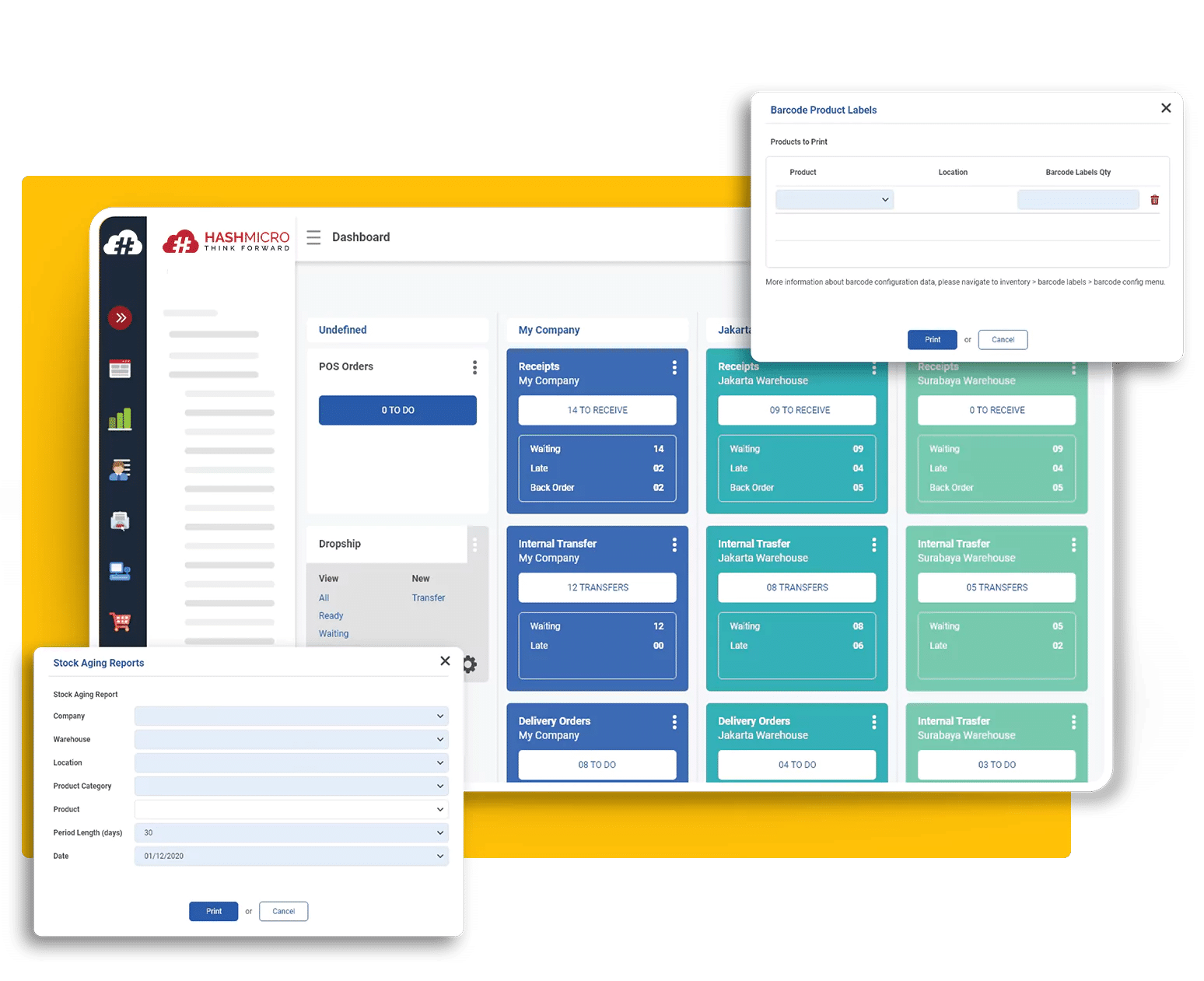Inventory management is a crucial aspect of running a successful business in Singapore’s competitive market. To ensure optimal efficiency and profitability, it is essential to employ effective inventory analysis strategies and utilize key metrics for decision-making.
This article will explore the concept of inventory analysis and the importances of inventory management software in the Singaporean business environment, providing insights and actionable strategies for effective inventory management.
Key Takeaways
|
Table of Content:
Table of Content

What Is Inventory Analysis?
Inventory analysis is the process of evaluating and reviewing a company’s inventory to gain actionable insights and make informed decisions. It involves analyzing various aspects such as stock levels, sales data, and cost factors to determine the optimal quantity of inventory to be maintained.
In Singapore’s dynamic business environment, inventory analysis holds significant importance. It plays a crucial role in maximizing profitability, reducing storage expenses, improving cash flow, and minimizing stockouts. By implementing effective inventory analysis techniques, businesses can streamline operations, enhance customer satisfaction, and gain a competitive edge.
Noteworthy benefits of inventory analysis are:
- Optimize inventory levels: By understanding demand patterns and sales data, companies can strike the right balance between having enough inventory to meet customer demand and avoiding excess stock that ties up working capital.
- Cost reduction: By examining cost factors such as carrying costs, storage expenses, and obsolescence risks, businesses can identify opportunities to minimize expenses and improve overall profitability.
- Improve cash flow by effectively managing the inflow and outflow of stock: By aligning inventory levels with demand patterns, companies can minimize the amount of capital tied up in inventory and free up resources for other crucial areas of the business.
- Minimizing stockouts: By monitoring inventory levels and demand fluctuations, businesses can ensure timely replenishment of stock, avoiding stockouts that could lead to lost sales and customer dissatisfaction.
In summary, inventory analysis is an essential aspect of effective inventory management in Singapore’s business environment. By leveraging this concept, businesses can optimize inventory levels, reduce costs, improve cash flow, and enhance customer satisfaction, ultimately driving overall success in the competitive market.
Goals of Inventory Analysis
Effective inventory analysis is crucial for businesses in Singapore to achieve their goals of increasing profits, reducing storage expenses, improving cash flow, and minimizing stockouts. By analyzing inventory data, businesses can gain valuable insights into sales patterns, demand fluctuations, and seasonality trends. This information enables them to optimize inventory levels, ensuring sufficient stock availability to meet customer demand while minimizing holding costs associated with excess inventory.
By implementing inventory analysis strategies, businesses can make data-driven decisions that maximize profitability and operational efficiency. For instance, the analysis helps in identifying slow-moving or obsolete stock, enabling businesses to take proactive measures such as clearance sales or markdowns. This reduces storage expenses and maximizes profitability.
Additionally, by understanding inventory trends and forecasting, businesses can reduce stockouts, leading to improved customer satisfaction and increased revenue.
Understanding the Different Types of Inventory
Effective inventory management is crucial for maintaining operational efficiency and meeting customer demand. Recognizing the various categories of inventory can aid businesses in optimizing their supply chain processes. The primary types of inventory include:
- Raw Materials: These are the basic inputs used in the production process to manufacture finished goods. For example, steel for car manufacturing or fabric for clothing production.
- Work-in-Progress (WIP): Items that are in the production process but are not yet completed. This includes partially assembled products or goods undergoing quality checks.
- Finished Goods: Products that have completed the production process and are ready for sale to customers. For instance, a fully assembled smartphone ready for distribution.
- Maintenance, Repair, and Operating (MRO) Supplies: Items used in the production process that are not part of the final product. This category includes lubricants, tools, and cleaning supplies essential for maintaining equipment and operations.
Understanding these inventory types enables businesses to implement more precise tracking and management strategies, ensuring a balanced and efficient supply chain.
How Do You Analyze Inventory?
Companies in Singapore can utilize various tools and techniques to effectively analyze their inventory. By analyzing stock and sales data, businesses can gain valuable insights into demand patterns, identify reorder points, and optimize their stock levels. This analysis enables companies to ensure that they have the right amount of inventory to meet customer demand without incurring unnecessary carrying costs.
Calculating relevant ratios is another method businesses can employ to assess inventory efficiency and profitability. The inventory turnover ratio, for instance, measures the number of times inventory is sold and replenished within a specific period. This ratio helps companies understand how quickly they are selling their inventory and can guide decisions on order quantities and stock management.
The gross margin ratio is another important metric that assesses the profitability of individual items or product categories. By analyzing this ratio, companies can gain insights into which products contribute the most to their overall profitability and focus their inventory management efforts accordingly.
In addition to ratios, Key Performance Indicators (KPIs) provide further insights into inventory management performance. KPIs such as fill rate, stockout rate, and carrying cost can help businesses track and improve their inventory accuracy, customer satisfaction, and overall operational efficiency.
By leveraging these analytical techniques, companies in Singapore can make data-driven decisions, effectively manage their inventory, and enhance their overall business performance.

Need to Know
Inventory Analysis Techniques
When it comes to managing inventory effectively, businesses in Singapore can benefit from employing various inventory analysis techniques. These techniques provide deeper insights into inventory management and help businesses optimize their inventory levels, improve customer service, and minimize costs. Let’s explore some of the most valuable inventory analysis techniques:
1. ABC Analysis
ABC analysis classifies inventory items based on their value or demand contribution. By categorizing items into three groups – A, B, and C – businesses can prioritize their inventory management efforts. A items are high-value items that require close attention, while C items are low-value items that can be managed more casually. This technique allows businesses to allocate their resources effectively and focus on items that contribute the most to their bottom line.
2. HML Analysis
HML Analysis, standing for High-Medium-Low analysis, is a technique used in inventory management focusing on the unit price of items. It categorizes inventory based on the cost per individual item or piece. This categorization is divided into three distinct groups:
- High Cost: This category includes items that have a high unit value. They represent the more expensive products in the inventory.
- Medium Cost: This group consists of items with a medium unit value, falling between the high and low categories.
- Low Cost: Comprising of items with a low unit value, this category includes the least expensive products.
A key aspect of HML Analysis is the listing of items in descending order of their unit value. This means that items are organized from highest to lowest unit cost.
3. VED Analysis
VED Analysis is an inventory analysis technique primarily used by manufacturing companies to evaluate the criticality of components and parts in their inventory. The acronym VED stands for Vital, Essential, and Desirable, representing three categories of inventory items based on their importance in the production process.
- Vital: Items classified as ‘Vital’ are those that are absolutely necessary for the production process. These are the components or parts without which production could come to a halt or be severely disrupted. It is imperative to always have these items in sufficient quantities in stock to ensure uninterrupted production.
- Essential: These are items that, while not as critical as vital components, are still important to have in the inventory. It is advisable to maintain at least a small quantity of these items. The absence of essential items might not stop production immediately but could lead to inefficiencies or delays in the manufacturing process.
- Desirable: Items in this category are those that are good to have on hand but are not critical to the ongoing production activities. Their absence does not significantly impact the manufacturing process. These are items for which stock levels can be lower, and they can be reordered less frequently or in smaller quantities compared to vital or essential items.
4. SDE Analysis
SDE Analysis is an inventory management technique that assesses items based on their scarcity and ease of acquisition. This method is particularly relevant in manufacturing contexts where various components are needed to assemble a final product. SDE stands for Scarce, Difficult, and Easily Available, representing three categories that reflect the availability and procurement challenges of inventory items.
- Scarce: Items in the ‘Scarce’ category are those that are hard to find and have limited availability. They often take a considerable amount of time to acquire, due to factors like limited suppliers, long lead times, or unique manufacturing processes. These items require careful tracking and proactive management to ensure they do not become bottlenecks in the production process. In the given example, marble inlays for a dining table, available from only one supplier, would be classified as ‘Scarce’.
- Difficult: This category includes items that are less scarce than those in the Scarce category but still pose significant challenges in terms of procurement. They may take several weeks to arrive, possibly due to fewer suppliers or specialized manufacturing requirements. These items also need careful management, but the urgency and difficulty are somewhat lower than for scarce items. For instance, unique wood components for a table top might fall into this category.
- Easily Available: Components classified as ‘Easily Available’ are those that can be acquired with relative ease. These items are readily available, often from multiple suppliers, and can be restocked quickly. They pose minimal procurement challenges. Examples include standard parts like screws in the furniture manufacturing example.
Key Inventory Analysis Metrics
Then, there are also several key metrics about inventory analysis:
1. Gross Margin Return on Invested Inventory (GMROI)
Gross Margin Return on Invested Inventory (GMROI) is a key metric used in retail and other inventory-intensive businesses to assess how effectively a company turns its inventory into profits. This metric provides insights into the profitability and efficiency of a company’s inventory management.
The GMROI is calculated using the following formula:
GMROI = Gross profit margin / average cost of inventory on hand
- Gross Profit Margin: This is the profit a company makes after deducting the costs directly associated with producing or purchasing the goods it sells (i.e., the cost of goods sold). It is typically expressed as a percentage and indicates how much of each dollar of sales is retained as gross profit.
- Average Cost of Inventory on Hand: This represents the average monetary value of inventory held by the business over a certain period. It accounts for the costs involved in maintaining inventory, including the cost of the goods themselves and other related expenses.
A GMROI result above 1.0 is generally considered favorable. It means that the gross profit earned from inventory sales exceeds the cost of the inventory itself, indicating efficient inventory management and profitability. This metric is particularly useful for businesses to evaluate which products or product lines are the most profitable and to make informed decisions on inventory purchases and pricing strategies.
2. Available to Promise (ATP)
Available to Promise (ATP) is a critical measure used in inventory management and supply chain operations to determine the amount of product available for fulfilling customer orders at any given time. This metric is crucial for companies in providing accurate delivery dates to customers and efficiently managing their inventory levels.
The ATP is calculated using the following formula:
ATP = Quantity of Product on Hand + Supply (or Planned Orders) − Demand (or Sales Orders)
- Quantity of Product on Hand: This is the current stock level of the product available in the inventory. It represents the immediate availability of the product for shipment or delivery.
- Supply (or Planned Orders): This refers to the additional quantity of the product that is either on its way (in transit) or planned to be ordered or produced. It represents the future availability of the product that will add to the current stock.
- Demand (or Sales Orders): This is the total quantity of the product that has been ordered by customers but not yet delivered. It represents the current commitment of the stock to fulfill existing customer orders.
The ATP figure provides a snapshot of the available stock that can be promised to new customer orders, after accounting for existing inventory and subtracting the stock already committed to fulfill previous orders. A positive ATP value indicates that there are enough products available to meet new orders, while a negative value suggests a shortfall, indicating that the company may not be able to fulfill new orders immediately.
3. Inventory Turnover Rate (ITR)
The Inventory Turnover Rate (ITR) is a crucial financial metric used by businesses to evaluate how efficiently they are managing their inventory and how well their products are selling. It essentially measures the number of times a company has sold and replaced its inventory over a specific period.
The formula to calculate the Inventory Turnover Rate is:
ITR = Cost of Goods Sold (COGS) during specified period / Average Inventory during the period
- Cost of Goods Sold (COGS): This is the total cost of all the goods that a company has sold during the specified period. It includes the costs directly associated with the production or purchase of the goods, such as material costs, labor, and overheads directly tied to the production process.
- Average Inventory: This is the mean value of inventory held by the company during the period. It is usually calculated by adding the inventory at the beginning of the period to the inventory at the end of the period and then dividing by two. This average helps in smoothing out any seasonal or other fluctuations in inventory levels.
The Inventory Turnover Rate is a key indicator of how effectively a business is managing its inventory. A high turnover rate implies that a company is selling its inventory quickly and efficiently, which is generally positive as it indicates strong sales and effective inventory management. On the other hand, a low turnover rate could suggest overstocking, weak sales, or possibly issues with the product itself.
4. Stockout Rate (SR)
The Stockout Rate (SR) is a key performance indicator (KPI) in inventory management that measures the frequency at which a customer orders an item that is not available in stock. It’s an essential metric for understanding the effectiveness of inventory management and ensuring customer satisfaction.
The formula to calculate the Stockout Rate is:
SR = (Number of Stockout Orders / Total Customer Orders) × 100
- Number of Stockout Orders: This is the count of orders that could not be fulfilled due to the absence of the requested item in inventory. A stockout order occurs when a customer requests a product that is not available for sale at that moment.
- Total Customer Orders: This represents the total number of orders received from customers in a given period. It includes both orders that were successfully fulfilled and those that resulted in stockouts.
The Stockout Rate is typically expressed as a percentage. The goal is to keep this percentage as low as possible, ideally below 10% and as close to zero as possible. A low stockout rate indicates that the business is successful in maintaining adequate inventory levels to meet customer demand.
5. Customer Service Level (CSL)
The Customer Service Level (CSL) is a metric used in inventory management to assess the probability of not experiencing a stockout, thereby avoiding a lost sale, over a specific period. It’s a measure of the effectiveness and reliability of a company’s inventory management in meeting customer demand.
The formula to calculate the Customer Service Level is:
CSL = (Products Delivered On Time / Total Products Sold) × 100
- Products Delivered On Time: This is the number of products that have been delivered to customers within the promised delivery timeframe. It reflects the company’s ability to fulfill orders as per the committed schedule.
- Total Products Sold: This represents the total number of products that have been ordered and sold in the specified period. It includes both on-time deliveries and any orders that may have been delayed.
The Customer Service Level is expressed as a percentage and is a crucial indicator of a company’s operational efficiency and customer satisfaction. A high CSL percentage indicates that the majority of products are being delivered as per the customer’s expectations, which is a sign of effective inventory management and strong supply chain operations.
Automate Inventory Analysis with HashMicro Inventory Software
Effective inventory management is crucial for maintaining operational efficiency and meeting customer demands. Traditional manual methods often lead to inaccuracies and inefficiencies, underscoring the need for advanced solutions. Implementing a cloud-based inventory management system offers real-time data access, scalability, and seamless integration with other business processes, thereby enhancing overall productivity.
HashMicro’s Inventory Management Software offers a comprehensive suite of features designed to streamline inventory processes and minimize errors. Key functionalities include:
- Barcode Management: Facilitates swift and precise tracking of stock movements across various locations, enhancing overall inventory accuracy.
- Lot and Serial Number Tracking: Automatically generates lot and serial numbers, simplifying product tracking within warehouses.
- Stock Request Management: Streamlines the management of stock requests from multiple outlets or warehouses, automating approval workflows to ensure timely replenishment.
- Inventory Forecasting: Utilizes advanced algorithms to predict future inventory demands, aiding in maintaining optimal stock levels and reducing the risk of overstocking or stockouts.
- Inventory Valuation: Performs inventory valuation across all warehouses at the end of each reporting period within a few seconds.
- Stock Aging Analysis: Analyzes the age of your stock, evaluates, and decides on future stock levels of slow and fast-moving items.
By integrating these features, HashMicro’s Inventory Management Software empowers businesses to make data-driven decisions, optimize stock levels, and enhance overall operational efficiency.
If you’re curious about the software, you can download the price scheme below!
Conclusion
Embracing inventory analysis is essential in staying ahead in Singapore’s ever-evolving business landscape and unlocking the full potential of your business. Remember, inventory analysis is not a one-time task, but an ongoing process that requires regular review and adjustment based on changing market dynamics and your business goals.
Take advantage of the various inventory analysis techniques available, such as ABC analysis to prioritize your inventory management efforts, average stock analysis to optimize stock levels, and monitoring stockout rates to minimize lost sales opportunities. Constantly monitor key metrics like profitability, storage expenses, and stock availability to assess your inventory performance and identify areas for improvement.
With effective inventory software, you can streamline your inventory management process and automate your inventory analysis. HashMicro inventory software is the best choice that may help you leverage your inventory management, especially in Singapore. HashMicro also offers discount up to 70% with CTC Grant. Try the free demo now!

Question About Inventory Analysis
-
-
-
What is the main objective of inventory analysis?
The primary goal of inventory analysis is to determine optimal stock levels to meet customer demand while avoiding overstocking or shortages. This involves evaluating sales data, demand patterns, and lead times to enhance purchasing and production decisions, ultimately improving efficiency and profitability.
-
What are the challenges in conducting inventory analysis?
Challenges include data accuracy, demand variability, and aligning inventory strategies with business objectives. Overcoming these requires robust data management systems and cross-functional collaboration.
-
How can technology enhance inventory analysis?
Implementing inventory management software automates data collection and analysis, providing real-time insights. Technologies like RFID and IoT devices further enhance tracking accuracy and inventory visibility.
-
-






































